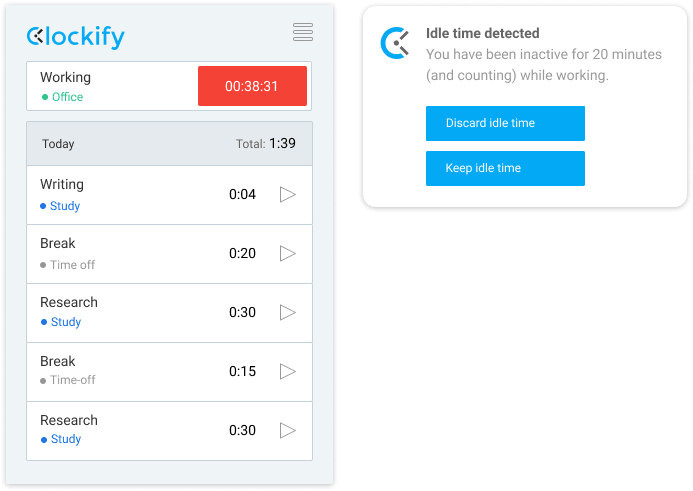Pomodoro Timer
Flexible and easy to use online Pomodoro timer. Track time spent on tasks, stay focused, analyze data, and improve productivity.
Completely FREE.





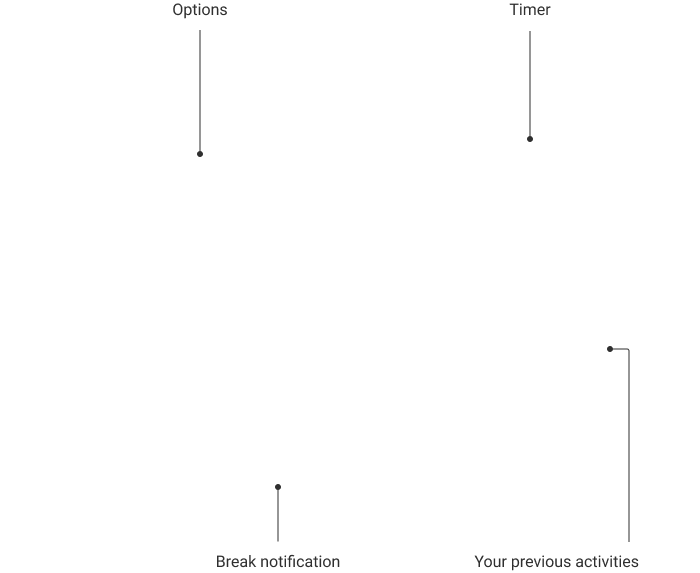
What is Pomodoro technique
Pomodoro is a time management technique for improving productivity. It involves working in 25-minute intervals, separated by short 5-minute breaks.
Improve Focus
By picking one task and writing it down, you commit to only doing that one task.
Cut Down Distractions
You'll postpone checking social media and emails for when the break starts.
Increase Accountability
The act of starting a timer gives you the mental commitment to start working on the task.

How to use Clockify Pomodoro Timer
Enable Pomodoro timer
Clockify is a time tracker that comes with built-in Pomodoro timer
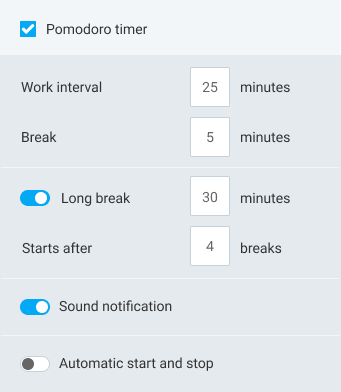
Start timer
Start a timer with one click/keystroke. You can also type what you're working on and categorize your activity

Take a break
After 25 minutes, you'll get a notification that it's time to take a break.


Continue working
After 5 minutes, you'll get a notification that it's time to get back to work.
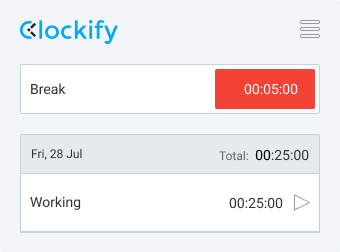

Repeat
All your work and break sessions appear in the list.

Enable Focus mode
Hide time logs and just see worked vs remaining time.
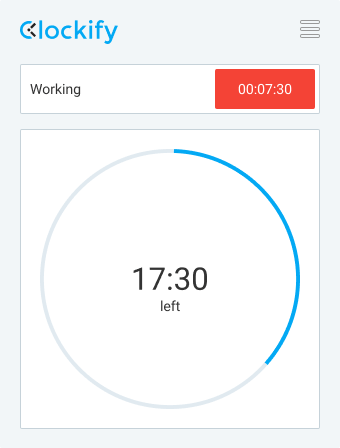
Take a long break
After 4 works sessions (and 3 breaks), reward yourself with a longer, 30-minute break

Analyze productivity
Clockify breaks down all your activities so you can see how productive you were across days and weeks.
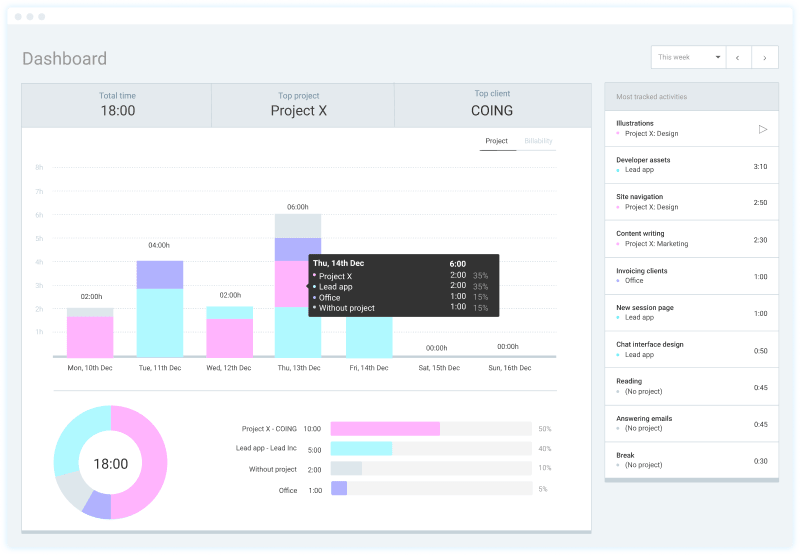
About Pomodoro Technique
What is Pomodoro time?
Pomodoro time is a 25-minute interval followed by a 5-minute break. Each interval is known as a Pomodoro, from the Italian word for tomato, after the tomato-shaped kitchen timer. The Pomodoro time management technique was developed by Francesco Cirillo in the late 1980s.
How Pomodoro technique works?
- Start a timer
- Work for 25 minutes
- Take a break for 5 minutes
- Every four Pomodoros, take a longer break (20-30 minutes)
What to do during a Pomodoro break?
During a 5 minute break, you can answer emails, return a phone call, clean, check social media, watch a video, get coffee or a snack, stand up and stretch, do some quick workout (handstand, push-ups, sit-ups), shoot some darts, look outside the window, listen to music, pet animals, or simply kick back and enjoy your break.
Why is Pomodoro 25 minutes?
There's nothing magic about 25 minutes. It's simply a recommendation to start with, one that's neither too short nor too long. Depending on who you are and what type of work you do, you'll need to adjust the length and find your own optimum work length
Why is Pomodoro effective?
Research has shown that multitasking is bad, while regular breaks and routines are good for productivity. Pomodoro is effective because it helps you focus on a single task, plan your breaks and distractions in advance, makes you accountable by stating what you're working on, and establishes a routine and rhythm in your life.
Does Pomodoro work for studying?
Pomodoro was initially developed to help students study. Later, the technique proved so useful that it spread and adopted for a wide variety of activities. Pomodoro now works for studying, writing, office work, development, and any other profession that requires self-directed focus and avoiding distractions.
Pomodoro Benefits
Francesco Cirillo, the creator of the Pomodoro Technique, had trouble staying focused while studying. So he put a time limit on how long he planned to focus on a single task and rewarded himself with a break. And it worked, for him and for millions of other Pomodoro practitioners.
Focus on tasks and cut interruptions
Tracking time discourages multitasking. When you write down that you'll work on that particular thing, you'll get into a flow state quicker.
The more often you disengage from your work due to interruptions, the more time you spend re-engaging with what you actually want to be doing. But when you're focused on one thing for a long period of time, you are able to get deeper into it.
Know how much effort activities really take
Record how many Pomodoros a task takes and how many Pomodoros you do in a day so you can:
- Know exactly how much time a task took you
- Avoid underestimating needed time and effort
- Accurately predict how long a similar task will take in the future
- Know how much time to set aside when the task comes up again
Improve your health
If your job involves sitting and staring at the screen the whole day, your body needs a break. Optometrist often advise the 20/20/20 rule for preventing eye strain: every 20 minutes, look at something 20 feet away for 20 seconds.
In addition to resting your eyes, use the break to stand up, do some deep breathing, and stretch (common advice is to stand up and move around every 30 minutes).
Prevent burnout
Being able to take short breaks, you'll be able to work longer and not get completely exhausted mentally. Just as walking around or stretching gives your body a break from sitting in one spot, letting your mind wander gives it a break.
Breaks give your mind a chance to solve problems without you getting in the way. Another benefit is that while you're on the break, you can do time wasting stuff, like checking emails or social media. That way, you won't check your email because you'll know that the break is coming soon.
Make work manageable
Blocking your day into identical chunks makes it easy to build and plan your day. This helps you think about your time in terms of "Hmm, I can do four more Pomodoros before lunch, and four more afterwards".
Get motivation to get stuff done
When you know you're on the timer, you'll feel accountability because your time logs will always tell the truth.
Knowing that the timer is running will pressure you to keep working and avoid distraction. And break timer will keep you from getting lost on YouTube for hours.
Problems with Pomodoro
The biggest problem with Pomodoro is that the timer prevents you from getting fully engaged and immersed in a task. Other issues are of more practical nature, like what to do if a client calls you in the middle of the Pomodoro.
Disrupts deep work
Pomodoro is great when you do tasks you don't want to do (like studying for an exam) or tasks that require little thought (like copying and pasting data). The short duration of Pomodoros and promise of a break as a reward encourages you to stay focused and do what you need to do.
But creative tasks (like writing or coding) suffer when you take frequent breaks. Limiting how much time you dedicate to those tasks will prevent you from getting fully immersed. When you're excited and fully immersed in your work, the timer pulls you out of your flow state and forces you to take a break.
This causes frustration because it interrupts you when you get going and are making real progress. Also, when you come back to work, you need time to get back into the flow and get your bearings.
Clock watching is distracting
When you're on the clock, you're forced to work longer than necessary. Sometimes you're simply too exhausted and the Pomodoro drags on forever and all you think about is the five minute break, which ends too quickly. This leads to constantly checking the timer and disengaging from work. When you're so conscious of time passing, it's impossible to devote all your attention to work.
Unrealistic work expectations
It's unrealistic to expect to work without interruptions. Sometimes life happens and thing need an immediate response: someone invites you to lunch, you get a phone call from a client, or you really need to go to the bathroom.
There are a lot of good reasons to break a Pomodoro, but the act will only make you feel like you've failed (or make you wonder should that 15m count as a partial Pomodoro, which is only the first step of the rabbit hole about the exact nature of the rules).
Doesn't work for everyone
Pomodoro works wonderfully when you need long stretches of uninterrupted work, but need motivation and a shield against distractions. Like when you're studying, writing, or programming. But if your profession involves a lot of collaboration, Pomodoro only gets in the way.
Helping a team member and tight collaboration is more important than worrying about breaking a Pomodoro. Pomodoro also doesn't work in professions where you have a lot of small stuff to do or can't divide an activity across several intervals (eg. surgery).
Pomodoro doesn't work for you?
To get the most out of Pomodoro, you need to customize it and make it suit your personal style and work requirements.
Find the combination that works for you
For some, 25 minutes is just enough time to work without losing focus and getting distracted. For others, 25 minutes may be too little. If you like the concept of the technique, you can it work for you by tweaking the increments.
It's unrealistic for most people in most jobs, to break work into 25-minute chunks. Sometimes you need more, sometimes less, and sometimes you don't need the Pomodoro at all. It's all about figuring out what works best for you.
For example, if you found that 25 minutes is just too short to get into work requiring deep focus, you can block time in increments of 45 minutes with a 15 minute break, and take a longer break after 2 cycles.
Or, you can split the day up into 4 blocks of 90 minutes of focused work and 30 minutes of rest. This gives you plenty of time to both get into the deep work and feel like you've had a satisfying break.
Postpone the break
If you find yourself deep into work and don't want to break the concentration, simply dismiss the notification, let the timer run, and take the break when you're ready.
if you think you need more time for a break, simply let the timer for the break run and start the work timer when you get back to work.
In the end, Clockify will show you how much time exactly you've spent working vs resting, so you can correct yourself in the future without having to be a slave to the rigid "you have to do this now" timer.
Track distractions
Life happens. Instead of resisting interruptions, address and keep track of them. This way, your team won't suffer and you'll keep track of where the time really goes.
When you're interrupted, you can start a new a timer from your keyboard and later fill in the details. Or, you can discard inactive time from the current timer and manually add the time you've spent on dealing with the interruptions.
The flexible workflow makes necessary switching between tasks easy. You never have to "just take this one call" while you're trying to finish a Pomodoro.
